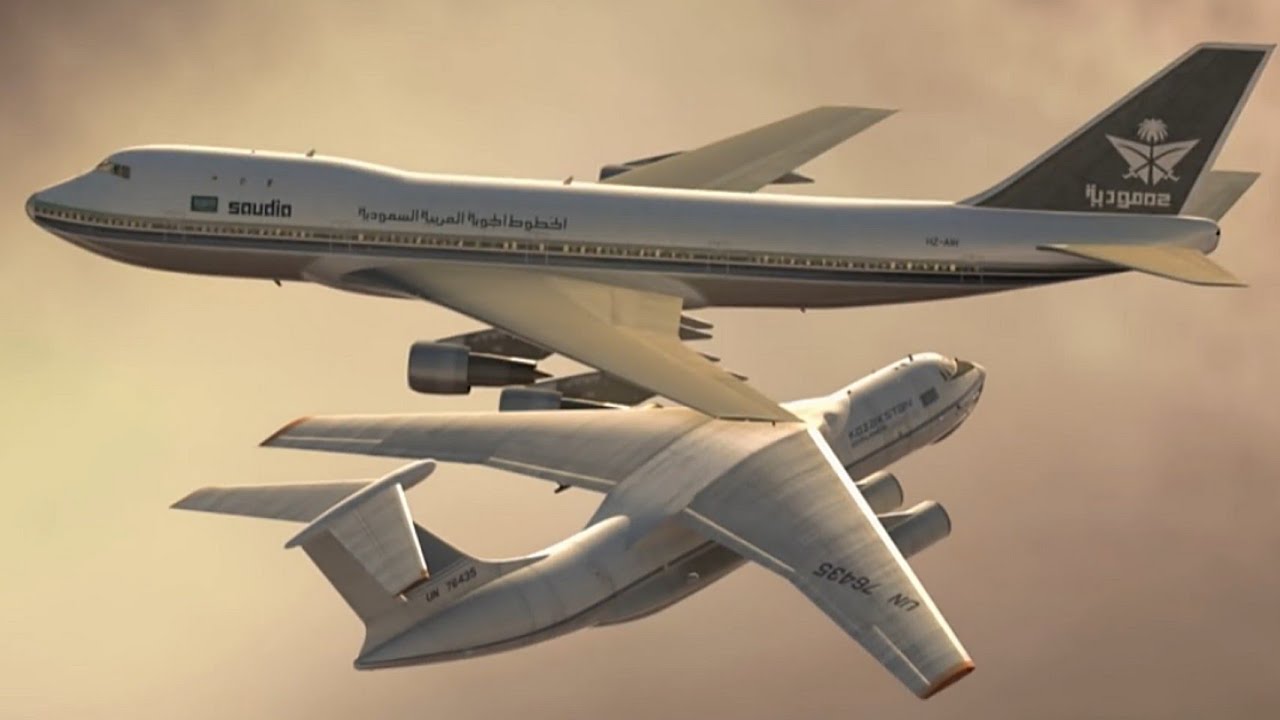Mid-air collisions are exceptionally rare but present some of the most horrifying crashes in history. There is almost no possibility for survival, given the high rate of speed and altitude these crashes typically occur. This article recaps the five worst mid-air collisions based on fatalities.
Charkhi Dadri Mid-air Collision
On November 12, 1996, a Saudi Arabian Airlines 747-100B collided with a Kazakhstan Airlines Ilyushin IL-76, just west of New Delhi, India. Three hundred forty-nine individuals were killed. Now called the Charkhi Dadri mid-air collision, it remains the world's deadliest mid-air collision, with 349 fatalities. The 747, flying as SV763, was en route to Dharan (DHA) from Delhi (DEL), while the IL-76, flying as KZ1907, was en route to Shymkent (CIT) from Delhi (DEL).

In this case, the left wing of the IL-76 sliced through the left wing of the 747, while the left horizontal stabilizer of the 747 sliced off the vertical stabilizer of the IL-76. The final cause was determined to be a pilot error on the part of Kazakhstan Airlines for a failure to follow air traffic control instructions, likely due to communication error or turbulence. The aircraft had descended to a lower level than assigned by ATC.
1979 Dniprodzerzhynsk Mid-air Collision
In 1979, Aeroflot Flights 7628 and 7880 collided with each other near Dniprodzerzhynsk (now Kamianske), leaving 178 dead. Involved was a Tupolev Tu-134A carrying 94 passengers and crew en route to Chișinău (KIV) from Voronezh (VOZ) along with a Tupolev Tu-134 AK carrying 84 passengers en route to Minsk (MHP) from Donetsk (DOK).

It was found that the cause of the crash was numerous air traffic control mistakes causing the aircraft to cross paths. More specifically, the controller denied key pilot requests requesting altitudes for climb and descent by both aircraft that would have guaranteed safety.
Zagreb Mid-air Collision
On September 10, 1976, British Airways Flight 476, a Hawker Siddeley Trident en route from London (LHR) to Istanbul (ISL, formerly IST), collided mid-air with Inex-Adria Aviopromet Flight 550, a McDonnell Douglas DC-9 en route from Split, modern-day Croatia (SPU) to Cologne (CGN). All 176 people were killed.

The collision occurred near Zagreb, the modern-day capital of Croatia. Investigators determined the crash was due to a procedural error by air traffic controllers in Zagreb. At the time, Zagreb air traffic control was known for being very busy yet equally understaffed. To date, it is the only fatal accident in the history of British Airways.
ANA Flight 58
On July 30, 1971, a Japan Air Self-Defense Force (JASDF) F-86F Sabre jet fighter collided with the ANA Flight 58, a Boeing 727. Flight 58 was traveling from Sapporo (CTS) to Tokyo-Haneda (HND). All 162 people onboard Flight 58 were killed, while the JASDF pilot successfully removed himself and parachuted to the ground unharmed.

The JASDF trainee pilot was only 22 and was doing training exercises on air combat maneuvering. Interestingly, he could not eject himself from the aircraft at first because the aircraft entered a spin after the collision; instead, he unbuckled his seat belt and escaped.
The trainee pilot was acquitted of a charge of involuntary manslaughter. Still, the instructor—who was not in the aircraft at the time—was found guilty of criminally negligent manslaughter, sentenced to three years in prison, and faced a three-year suspension. At the time, the accident was the deadliest aviation incident and remains the most fatal in ANA's history.
Libyan Arab Airlines Flight 1103
On December 22, 1992, Libyan Arab Airlines Flight 1103 collided with a Libyan Air Force Mikoyan-Gurevich MiG-23UB, leading to 157 fatalities on board flight 1103 (no survivors). The two individuals in the Libyan Air Force aircraft successfully ejected. Flight 1103 was en route from Benina (BEN) to Tripoli (TIP, now closed).

The following investigation blamed the individuals in the Libyan Air Force aircraft, both of whom were arrested and imprisoned soon following. However, the Libyan Civil Authority was ordered not to release any information on the crash by the Libyan government.
Indeed, the events in the crash have been disputed in the following years. One of the individuals on board the Air Force aircraft, Major Abdel Majid Al-Tayari, claims Flight 1103 was deliberately destroyed by an explosion unrelated to the MiG-23UB. Additionally, Ali Aujali, a former Libyan diplomat for Gaddafi and the National Transitional Council, claims that Gaddafi intentionally ordered Flight 1103 to be shot down—on the date exactly four years to the day after the bombing of Pan Am Flight 103 no less—to "demonstrate the negative effects of international sanctions imposed on Libya."

Honorable Mentions
The first fatal mid-air collision, while not the most deadly, is quite important in establishing precedent. The crash occurred in Douai, France, on June 19, 1912. Two French army aircraft collided with one another, killing both pilots.
The Federal Aviation Act of 1958 created the FAA after two mid-air collisions in quick succession: a collision between United Airlines Flight 736 and an F-100 belonging to the US Air Force and a collision involving Capital Airlines Flight 300 and another Air Force aircraft. While the total fatality count was 61 between the two crashes, the result was a sweeping reorganization of air traffic control and the FAA that paved the way for improved aircraft safety across the United States.
Comments (1)
 a
Absolutely no idea what the weird British Airways image is, but it's neither of the Zagreb collision or a Trident.
a
Absolutely no idea what the weird British Airways image is, but it's neither of the Zagreb collision or a Trident.
Add Your Comment
SHARE
TAGS
INFORMATIONAL Safety FAA Crash Incident Collision History India Russia Croatia Japan Libya France US Libyan Arab Airlines ANA British Airways Aeroflot Saudi Arabian Airlines Kazakhstan AirlinesRECENTLY PUBLISHED
 Learjet Owned By Vince Neil Crashes Into Gulfstream Jet, 1 Fatality Confirmed
On February 10th, around 14:30 local time, a Learjet private jet aircraft crashed into another private jet after landing at Scottsdale Airport (SCF) in Arizona.
NEWS
READ MORE »
Learjet Owned By Vince Neil Crashes Into Gulfstream Jet, 1 Fatality Confirmed
On February 10th, around 14:30 local time, a Learjet private jet aircraft crashed into another private jet after landing at Scottsdale Airport (SCF) in Arizona.
NEWS
READ MORE »
 Seattle Plane Strike 2025: Japan Airlines and Delta Collision Raises Safety Concerns
Seattle-Tacoma International Airport saw a concerning incident on Wednesday morning when a Japan Airlines (JAL) plane clipped a parked Delta Air Lines jet while taxiing. Thankfully, no one was injured, but passengers described the collision as a frightening experience.
NEWS
READ MORE »
Seattle Plane Strike 2025: Japan Airlines and Delta Collision Raises Safety Concerns
Seattle-Tacoma International Airport saw a concerning incident on Wednesday morning when a Japan Airlines (JAL) plane clipped a parked Delta Air Lines jet while taxiing. Thankfully, no one was injured, but passengers described the collision as a frightening experience.
NEWS
READ MORE »
 Ethiopian Airlines Expands Cargo Fleet with New Boeing 777 Freighter
Ethiopian Airlines has expanded its cargo fleet with a brand-new Boeing 777 Freighter, registered as ET-BAB (MSN 68140). The aircraft was delivered directly from Boeing’s factory in Everett, Washington, USA, and landed at Addis Ababa Bole International Airport at 3:41 PM (GMT+3) on Wednesday, January 22, 2025.
NEWS
READ MORE »
Ethiopian Airlines Expands Cargo Fleet with New Boeing 777 Freighter
Ethiopian Airlines has expanded its cargo fleet with a brand-new Boeing 777 Freighter, registered as ET-BAB (MSN 68140). The aircraft was delivered directly from Boeing’s factory in Everett, Washington, USA, and landed at Addis Ababa Bole International Airport at 3:41 PM (GMT+3) on Wednesday, January 22, 2025.
NEWS
READ MORE »




